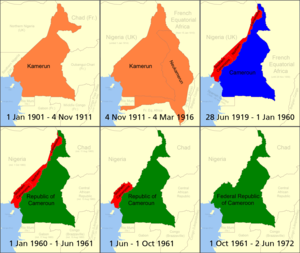| Neukamerun | |||||||||
|---|---|---|---|---|---|---|---|---|---|
| Part ofKamerun | |||||||||
| 1911–1916 | |||||||||
 Neukamerun | |||||||||
| • Type | Constitutional monarchy | ||||||||
| History | |||||||||
• Established | 1911 | ||||||||
• Disestablished | 1916 | ||||||||
| |||||||||
| Today part of | |||||||||

Neukamerunwas the name ofCentral Africanterritories ceded by theThird French Republicto theGerman Empirein 1911. Upon taking office in 1907,Theodor Seitz,governor ofKamerun,advocated the acquisition of territories from theFrench Congo.[1]
In 1911, theAgadir Crisisbroke out over the question of French influence inMorocco.France and Germany agreed to negotiate on 9 July 1911, and on 4 November, they signed an agreement. In exchange for German recognition of France's rights to Morocco[2]and a strip of land in northeastern Kamerun nearFort Lamybetween theLogoneandCharirivers, France agreed to cede part of the French Congo to Germany. Germany's only major river outlet from its Central African possessions was theCongo River,and the Germans hoped that more territories to the east of Kamerun would allow for better access to that waterway.[3]
Accordingly, Kamerun gained a connection to the Congo centered on theSangha Riverand another to theUbangiat the town ofZinga;a small strip of French territory lay enclosed by the two outlets. Also included was a strip from northernGabonthat resulted in the Spanish colony ofRio Munibecoming surrounded.[4]In total, the Kamerun colony grew from 465,000 km2to 760,000 km2.[2]Otto Gleimwas governor of Kamerun at the time. The expanded colony became known as Grand Kamerun.[5]The transfer took two years, and was completed when Ouham Region of Ubangi-Shari was transferred on June 1, 1913.[6]
The exchange sparked debate in Germany; opponents argued that the new territories presented little opportunity for commercial exploitation or other profit. The German colonial secretary eventually resigned over the matter.[2]
DuringWorld War I,France was eager to regain the territories.[7]In 1916, France seized the territories after the fall of German forces in western Africa. After the war, France administeredCamerounas aLeague of Nations mandatewhich was distinct from French Equatorial Africa. Neukamerun ceased to exist as the boundary was placed back at its pre-1911 line (except for the strip of land between the Logone and Chari rivers, which remained part of French Equatorial Africa). The territory today forms part ofChad,theCentral African Republic,theRepublic of the Congo,andGabon.[8]
Notes
editReferences
edit- DeLancey, Mark W., and DeLancey, Mark Dike (2000).Historical Dictionary of the Republic of Cameroon(3rd ed.). Lanham, Maryland: The Scarecrow Press.ISBN0-8108-3775-7.
- Hoffmann, Florian (2007).Okkupation und Militärverwaltung in Kamerun. Etablierung und Institutionalisierung des kolonialen Gewaltmonopols.Göttingen: Cuvillier.ISBN978-3-86727-472-2
- Marquardsen H., et al. (1914). "Die Grenzgebiete Kameruns Im Süden Und Osten; Hauptsächlich Auf Grund Der Ergebnisse Der Grenzexpeditionen. Mitteilungen Aus Den Deutschen Schutzgebieten. Ergänzungsheft," No. 9a. Ross Archive of African Images, Yale University Art Gallery. Yale University Open Community Collections, JSTOR,https://jstor.org/stable/community.36673070.Accessed 11 Oct. 2024.
- Neba, Aaron (1999).Modern Geography of the Republic of Cameroon,3rd ed. Bamenda: Neba Publishers.ISBN0-941815-02-1.
- Ngoh, Victor Julius (1996).History of Cameroon Since 1800.Limbé: Presbook.ISBN0-333-47121-0.
- Map of KamerunArchived2007-07-11 at theWayback Machine
- Bradshaw, Richard., & Fandos-Rius, J. (2016).Historical dictionary of the Central African RepublicNew edition.ISBN0810879913.